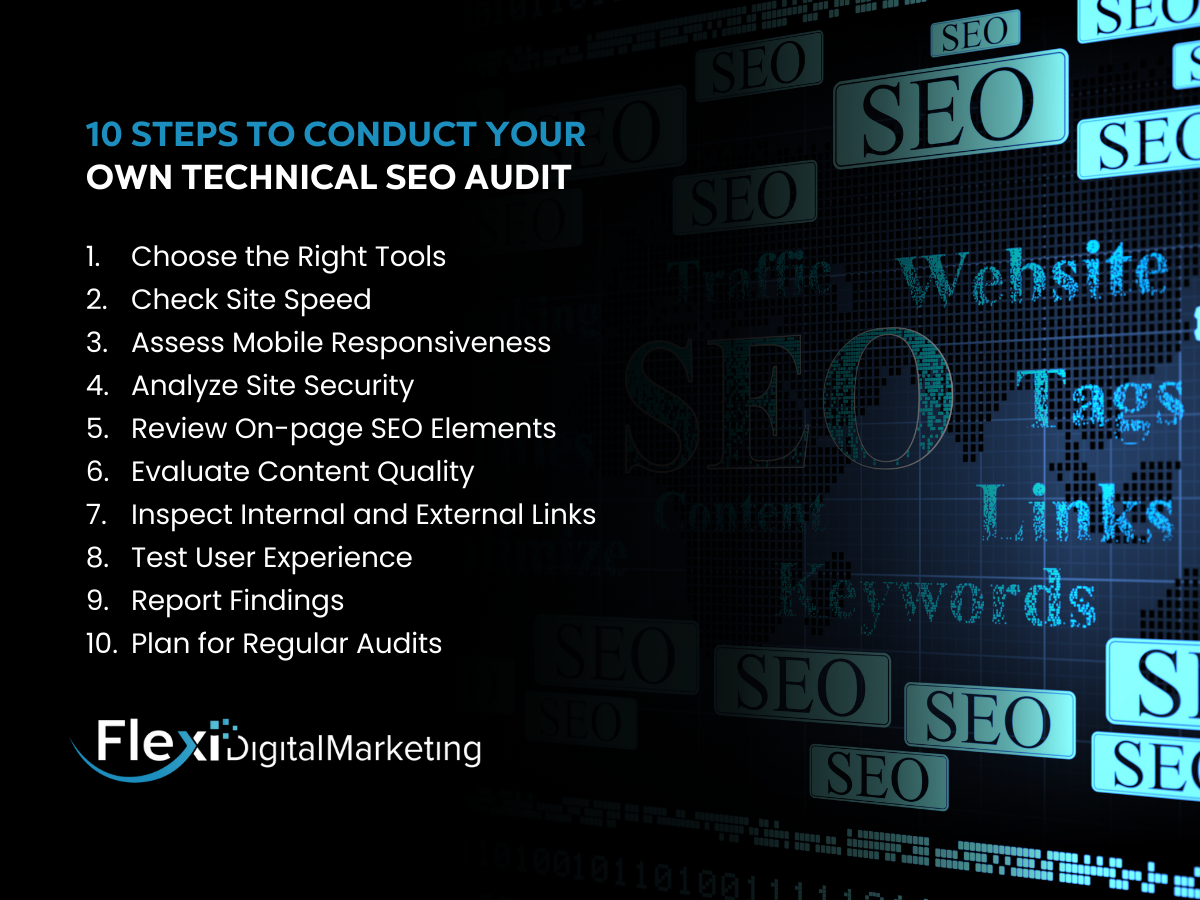Did you know you can enhance user experience and create better engagement results by performing a technical SEO audit? Performing proper auditing on your technical SEO ensures the crawlability, performance, and speed of your website.
After all, how can your SEO attract more customers if it fails to even function on its linked pages? Furthermore, any SEO guide will remind you that your website’s technical malfunctions will hurt your efforts.
To fix SEO issues, you’ll have to do an overall audit. There are many types of SEO audits involved in ensuring the quality of your efforts is well-measured and functioning at its optimal level.
Why don’t we get started with your journey on SEO auditing with technical SEO? Below you’ll find the definition of technical SEO, why it’s essential, what to check, how to check it, and tools you can utilise to check them.
What is Technical SEO?
Before we begin learning about technical SEO audits, we should first define what we’re auditing. Technical SEO refers to the modern requirements necessary inside a website for search engines to crawl and rank your content organically.
Failure to properly match technical SEO requirements will likely result in low rankings no matter how engaging or unique your content may be. Why? Because users will likely not see it. The basic options are ensuring crawlability for search engines like Google to visit your website.
However, if you want to rank faster, higher, and with more impressive results, you will need to continuously master your technical SEO.
Why is Auditing Technical SEO Essential?
You might be wondering why it’s essential if you can still rank with the basic technical SEO requirements. The reason isn’t just to enhance your website’s ranking capabilities. There can be some instances where your content fails to rank due to errors and issues related.
You might make the best content for social media in SEO, then wonder why it’s not ranking still. Only to find out that you have technical malfunctions that would have gone unchecked if you hadn’t noticed the analysis of your engagement.
A technical SEO audit maintained at a regular rate prevents wasted time and effort while ensuring you reach your targeted audience.
5 Essential Components of a Technical SEO Audit
Whether it’s an American website or an Australian, SEO tips regarding auditing the technical side of your website should keep in mind these five crucial parts of a checklist.
Site Speed: How Fast Does Your Page Load?
An important part of your website is its speed. Too many website owners undermine the importance of your page’s loading time and think that it’s not as necessary as other functions.
However, if your website loads particularly slowly in comparison to other websites, this could make you lose engagement faster than you’d expect. Website traffic is also enhanced when your site speed increases.
Mobile Responsiveness: Mobile Optimisation is a Requirement
The times when mobile devices didn’t utilise the Internet have long passed. Nowadays, everyone utilises their mobile devices to access the Internet. That includes looking into your content and website.
So what happens if your website isn’t optimised for mobile devices? It becomes unreadable, unusable, and difficult to navigate for users.
Crawl Errors: Searching and Fixing Redirects and Broken Links
Another thing to look into when performing a technical SEO audit is any broken links, redirect errors, and any other crawl errors.
Search engines like Google or Bing rely heavily on your crawlability to rank your website’s content. Should you fail to have an organised website with working redirects and links, this could result in errors that will make it harder for the search engines to rank you.
The worst-case scenario could even lead to your content’s meta description not showing on search engine result pages (SERPs) making it less likely to be clicked on.
Having a healthy crawlability for your website also ensures that any insights and SEO health-checking tools can accurately depict your errors or needs.
Security Features: HTTPS and Other Security Protocols
A technical SEO audit would be incomplete without checking in on a website’s security features. This especially includes HTTPS and other security protocols you have applied to your website.
Technical SEO isn’t just about ensuring you rank well with search engines. It’s also about how your website’s data won’t easily be compromised by malicious outsiders. Nowadays, criminals have also transferred their schemes to the digital world.
We suggest using HTTPS to protect your data and ensure the security of your users and employees working on the website. HTTPS, which stands for Hypertext Transfer Process Security, ensures that any outside forces that attempt to intercept your connection with your users will only receive non-sensible data.
This ensures the safety of your brand’s interactions and content with its clients and users. However, there are other security protocols you can utilise aside from HTTPS as well. An example of this would be multi-factor authentication processes.
SEO Tags: Meta Tags, Alt Tags, and Headers
SEO tags are a key figure in any technical SEO audit. HTML SEO tags are simply code that describes what your content is about in your website to search engines. These tags help search engines with instructions, give them an idea of what the content is about, and describe any images on the content page.
Depending on how you utilise SEO tags it’s even possible to secure higher SERP spots by becoming featured snippets on the search engine. Double-check your meta tags, alt tags, and headers to speed up crawlability and ranking.
10 Steps to Conduct Your Technical SEO Audit
Now that we know what to put in an SEO audit checklist for technical requirements, it’s time to learn how to check them in an organised manner. Below are 10 steps you can utilise while maintaining your website’s technical SEO performance.

Choose the Right Tools
Before you begin the process of auditing your technical SEO you should first choose and use a set of tools that you need for your auditing process. There are many tools you can use to perform your technical audits for SEO.
Keep in mind that these tools should include the ability to check the technical performance of your websites. Some of these can include insights on your analytics, security, speed, and more. Read more to find out our suggested tools to choose from.
Check Site Speed
The next step on your checklist is maintaining an optimised site speed. Just as we have discussed earlier, your site speed is crucial to the engagement with your users. Should you fail to have a fast site speed you risk potential clients and users.
To improve your site speed during technical SEO audits, try optimising your images, limiting HTTP requests, and removing unnecessary render-blocking JavaScripts.
Assess Mobile Responsiveness
Included with site speed is the responsiveness of your website on mobile devices. How many seconds did it take for your website to respond on a mobile device? Is it user-friendly when accessed on said devices? Is it easy to understand and read?
These are just some of the questions you should ask yourself when doing your technical auditing. Now that there are many mobile devices in different sizes and shapes, it’s important to increase your optimisation to enhance user experience and encourage further engagement.
Analyse Site Security
We cannot stress enough how important the security of your website is. Many have fallen prey to malicious external and internal forces trying to breach their data. Retain the confidence and trust of your users by ensuring their private information on your website is secure.
Regularly checking in on your site’s security procedures and for any anomalies is a technical SEO audit template. Remember, no matter how small your business is, if its data is on the Internet, there’s a chance someone could breach it.
Review On-page SEO Elements
A quick run-through of your on-page SEO elements is important as well. Content is crucial to maintaining your user’s interests. However, as this is all about the technical side, we’re referring to the elements that make up an on-page SEO.
These elements include links, meta descriptions, page speed, keywords, image optimisation, and more. Ensuring that these elements are working, clear, and provide the standard speed and content is crucial to continue a pleasant user experience where the users find exactly what they seek from you.
Evaluate Content Quality
The quality of your content is also included in a technical SEO audit. There are many instances when the quality of the content provided is low, the chances are that it will be glossed over by users and lower its ranking.
To prevent this, ensure your content is up to date and that its readability is at its optimised percentage. Searchability is also a factor in content quality. How easy is it to search your user’s content? This means not stuffing your content with keywords just to get a rank as well.
Inspect Internal and External Links
This might sound taxing, but internal and external links that you place on your content also have something to do with your technical SEO. Unfortunately, even if it wasn’t your intention to link your content to a broken website or were not aware that the link you provided redirects to an error, it still causes a downside effect to your ranking.
Broken links, which refer to links that no longer lead to a page with the desired content, are often overlooked. Not on purpose, but mostly because the link itself became unavailable without anyone noticing.
That’s why you need to inspect your internal and external links for any errors that could come up and replace them with similar content information. Using technical SEO tools to identify the broken link is the best way to save time.
Test User Experience
Once you have done all the necessary steps for a technical SEO audit it’s time to do some quality testing. Test the user-end experience to ensure that there are no visible errors and grievances your potential customers come across.
This includes ensuring your navigational functions work at an efficient speed, all your links redirect to the proper landing page, and that it provides what the user first searched for.
Report Findings
Reporting your findings after finishing your audits is important for future reference. As the team reviews the weak points of your technical SEO, improvement and smoother auditing can be performed.
Everyone must be made aware of the weak links that build up a website’s technical SEO for improvement. As your brand grows, so does your website’s need for capacity. Clearing the potential errors before they occur now is a great way to continue growing in a fast and effective way.
Plan for Regular Audits
The last step of your technical SEO audit checklist is to plan for regular audits. Ensuring the quality of your technical SEO maintains its optimal level is a crucial part of your website’s growth.
Regularly auditing your website should follow a schedule that all team members are aware of. Doing so this increases the likelihood of faster growth, more users visiting, and your content ranking the SERPs higher than ever.
6 Must-Have Tools for Technical SEO Audits
There are many ways you can audit your technical SEO. However, there’s no crime in using a website technical audit tool. Make your life easier by utilising these five must-have tools when auditing your technical SEO.
Google Search Console
It’s no surprise that at the top of the list of our tools is Google Search Console. Unlike other SEO auditing tools, GSC is directly connected to the Google search engine.
That way you can accurately see where your website and its content ranks and its performance among the most popular search engines in the world. However, you can also check your website’s performance using PageSpeed Insights.
SEMrush or Ahrefs
Two world-renowned SEO tools are utilised for content creation and auditing: Ahrefs and SEMrush. These two SEO tools have become the lead in content creation and search engine optimisation for years because of their efficiency.
Ahrefs describes itself as an all-in-one marketing platform that compares your websites with competitors, provides keyword search results, tracks your ranking, and continuously audits your website.
The same can be said of Semrush, which boasts over 300,000-page limits that it can crawl and audit.
GTmetrix
Just like with other technical SEO auditing tools, GTmetrix provides support in ways that the user wouldn’t notice.
GTmetrix prioritises the speed of your website. It’s a free tool that gives you detailed reports on your website’s performance using Google Page Speed and YSlow guidelines. Unlike other tools, GTmetrix’s goal is to ensure your website’s speed and front end maintain the optimal requirements and standard practices.
You could also try other website speed-checking tools. Pingdom is another amazing SEO auditing tool that utilises a unique method: synthetic monitoring. Pingdom notifies its clients about the speed of their website, its availability, and if any links or functions are running errors.
Screaming Frog SEO Spider
Despite their peculiar name, Screaming Frog doesn’t have anything to do with frogs at all. Instead, it’s more known for its exemplary service as a crawlability tool. The Screaming Frog SEO Spider is a website crawler that audits common SEO issues for you.
This SEO technical auditing tool is a must-have since crawlability is such an important part of ranking on search engines. The best part of it is that it has a free version that can crawl over 500 URLs.
Should you want more than just the 500 you won’t have to look anywhere else. There’s a licence of $259 per year to remove some advanced features and limits.
Moz Pro
Just like Ahrefs and SEMrush, MozPro also doubles as an all-in-one tool. However, its priority focuses on generating leads and conversions with the insights it provides. Their insights are AI-powered to support your goal of becoming visible in search engines.
It even has a Search Visibility Score, which assesses your content and tells you what can be improved based on your content’s visibility and quality.
Conclusion
We hope you enjoyed learning about technical SEO audits and how to maintain your website’s SEO performance. Keep in mind that there’s more SEO auditing involved to create the best rankings possible for your content and your brand.
However, you might find yourself winded from all the information. Not to worry, here at Flexi Digital Marketing, we have expert SEO services ready to partner up and enhance your website’s performance! Start your project with us today!


